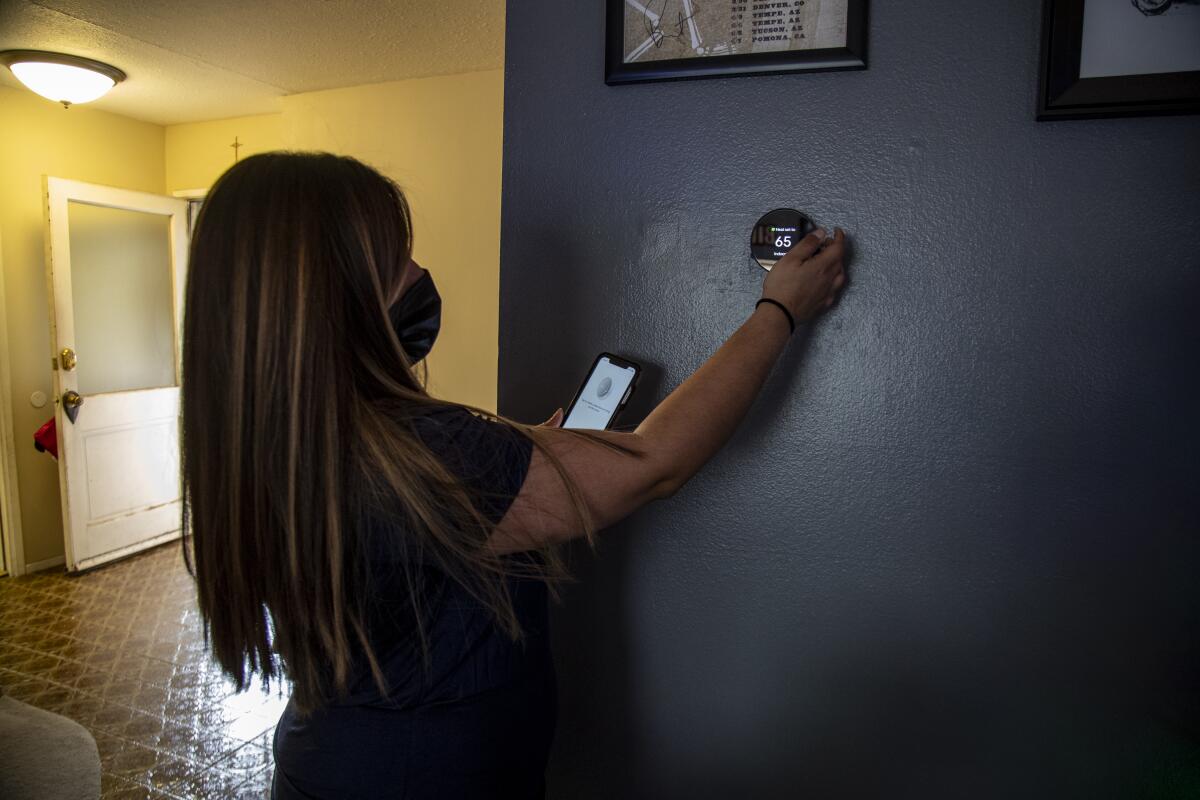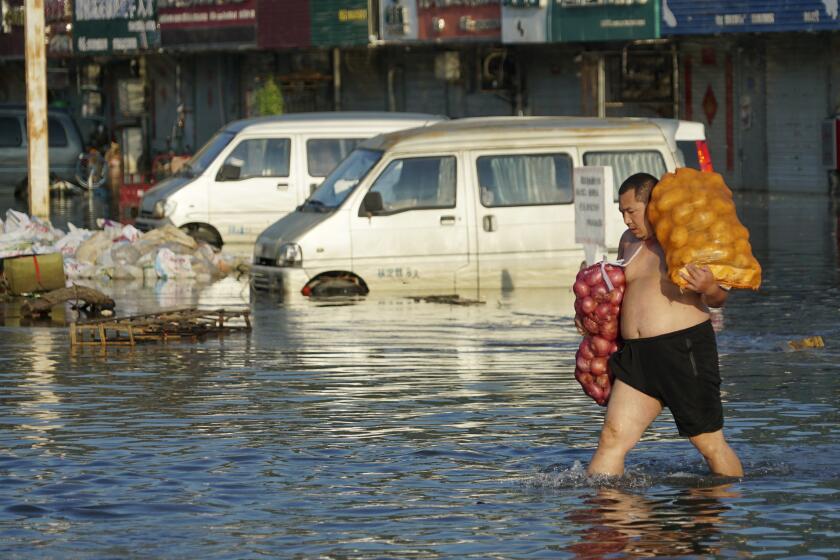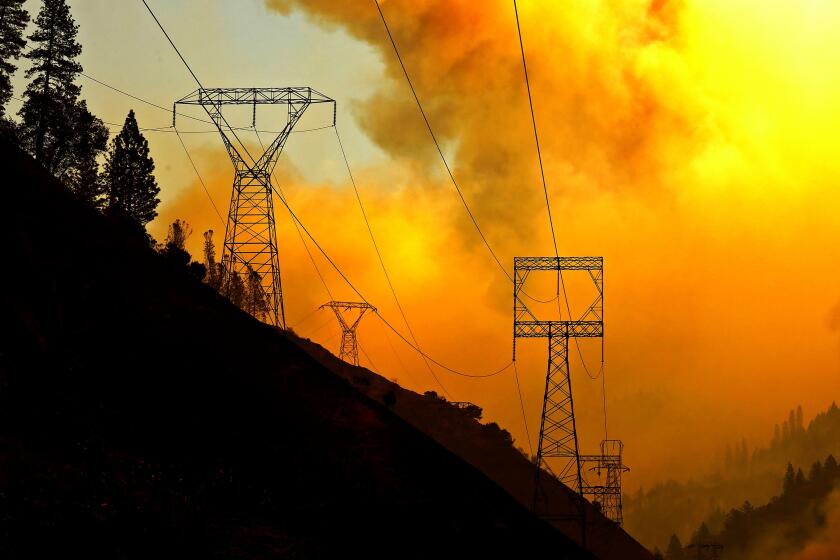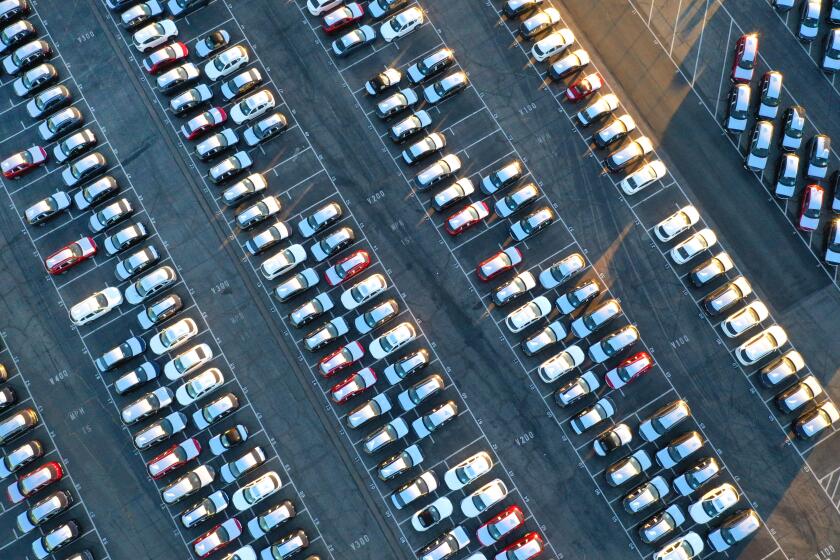The new report on climate change is dire. What can I do about it?

- Share via
We knew the latest United Nations report on climate change wasn’t going to be good news, but it’s still tough to hear: We haven’t come close to getting a handle on global warming — and that failure is triggering disastrous environmental consequences.
The scientific assessment was released this week by the Intergovernmental Panel on Climate Change, or IPCC for short. It concluded that, thanks to a continued rise in global temperatures, we can expect more wildfires, floods, heat waves and water shortages over the next 30 years. That’s a big problem, since the unprecedented rise in extreme events has already been causing massive levels of destruction.
Even if nations manage to impose the strongest cuts to greenhouse gas emissions, the planet is all but certain to exceed the 2015 Paris climate agreement’s more ambitious goal of limiting warming to 1.5 degrees Celsius (2.7 degrees Fahrenheit). That’s because we’ve already reached 1.1 degrees Celsius of warming since the 19th century — leaving less than half a degree of wiggle room.
Desperate as the situation sounds, the last thing climate experts and policymakers want is for people to feel so hopeless that they give up and tune out, said Katherine Konschnik, a climate policy expert at Duke University.
“That’s the biggest risk of a report like this” Konschnik said. All that bad news on a global scale “can be really disempowering because it’s frightening and feels too big.”
The U.N. says global warming is likely in the next two decades to pass 1.5 degrees Celsius — the ambitious target of the 2015 Paris climate agreement.
The situation may sound almost irreparable, but it’s not, experts say. It’s just going to be really, really hard to turn things around — and it’s going to require an unprecedented level of concerted effort to make the systemic changes needed to ensure a livable planet for all of us. And those changes need to happen fast, because the longer we delay, the more the Earth will warm — and the more difficult the task will become.
“We all need to do some part of the solution,” said Volker Sick, a mechanical engineer at the University of Michigan whose work focuses on ways to remove carbon dioxide from the air and turn it into useful products.
“We don’t have a silver bullet, one thing that fixes everything,” he said. “So we need individual action, we need policy action, new technology — we need to make changes in lots of things, but we need to do this with a system-level thinking.”
With that in mind, The Times asked several experts about the actions we can take to help reduce our impact on the climate.
Flex your purchasing power
“I think a lot of times,” Konschnik said, “people don’t realize the power they have as a consumer.”
If you’re comparing products, look into the companies behind them, their emissions and environmental impact, she said. Have they set goals for reducing carbon emissions? Have they given a clear explanation of how they’re going to get there?
“If not, and there’s a competitor that’s making a similar product that has made those commitments, then you know you can use your buying power to say, ‘I want to support the company that’s making these actionable pledges,’” she said.
If you have to buy appliances or electronics, check their efficiency ratings with the government-backed Energy Star program or something similar. (This has an added benefit: Choosing a more efficient appliance will likely save you money in the long run.)
It’s no secret that city folk like to eat, shop and travel.
You can also buy books, clothes and many other goods secondhand, which treads far more lightly on the environment. It’s less energy-intensive in part because the product is already made and materials don’t have to be transported, assembled and packaged to the same degree.
“Certainly there are times where you’re going to buy something [new],” Konschnik said. “There’s lots of other times when there are perfectly good used alternatives.”
And for nonessential goods, you can also make the radical choice not to buy at all.
In the midst of a very stressful time, “a lot of us are looking for just ways to quickly feel better, and buying is one of those things,” Konschnik said. But she suggested other low-carbon ways to unwind: unplugging your phone and going for a walk, spending time with a friend over a cup of tea, or taking your kid to the park and pushing them on the swings.
“You can’t buy those moments,” she said.
Insulate ... and lay off the thermostat
“Seriously, one of the most basic things is to insulate your home,” Konschnik said. “No matter where you live, insulating your home is just so important — and anyone can do it, even if you’re a renter and you live in an apartment.”
By way of example, she pointed to the plastic sheeting available at home-improvement stores that can be applied to windows to seal cracks and keep out cold air in the winter.
“They’re lower-cost activities, and they really do make a difference,” she said. “They can save energy costs for your family, and they can also make your home more comfortable while doing something positive for climate change. So that’s one of my favorite ones, even though it’s not the sexiest thing in the world.”
Talking about global warming with friends and family helps them learn key facts about the scientific agreement on climate change and influences their beliefs.
On a related note, try not to overheat or over-cool a room — there are less energy-intensive ways to make a space comfortable, said Sue Anne Bell, a professor of nursing at the University of Michigan who focuses on disaster preparedness and response.
“Set the thermostat two degrees higher in the summer and two degrees lower in the winter,” Bell suggested. “Put on a jacket if you feel cold, or sleep with a fan in the summer.”
The same goes for office buildings, Sick said.
“Why do we need to wear a jacket and a long-sleeve shirt to be comfortable in buildings in the summer because they have cooled to temperatures that are just uncomfortably low — versus in the winter, we want to sit in short-sleeve shirts in our offices?” he said. “Something is wrong here.”
Vote
If there’s one tried-and-true way that individuals can contribute to change on a societal scale, it’s by voting for people who take climate change seriously, several experts said.
“One of the most important things that individual citizens can do is for themselves to understand the problem, and support ... candidates for political office who understand the severity of the problem,” said Edward Parson, a climate policy expert at UCLA. That includes a recognition, he said, that “this is a challenge to human ingenuity and morality that’s of a scale really never seen before.”
Konschnik agreed, ticking off ways that voters can educate themselves and push their representatives in a greener direction: reading party platforms to see what they say about climate change; attending candidate forums and asking about candidates’ specific climate policy plans; and, of course, casting your ballot accordingly.
The black box of secrecy around corporations’ plans to cope with climate change could be unlocked amid a push by California and federal regulators.
If that seems like a lot of legwork, go ahead and lean on organizations such as the League of Conservation Voters, which tracks elected officials’ votes on climate and environmental issues.
“That’s a really quick way to see where a particular candidate or elected official stands relative to others,” Konschnik said.
See the big picture
Parson said he was wary of putting too much focus on individual-based solutions to climate change. Global warming is a collective problem, and it requires massive, collective action, he said.
“I have some serious difficulty with framing response to climate change in terms of what ‘I’ can do to contribute to the solution,” he said. “There are some limited ways that individual behavior change can make a non-trivial difference, but climate change is a problem of the aggregate emissions of human activities from 7.5 billion people in the world. ”
To be fair, a disproportionate amount of those emissions are produced by 1 billion to 2 billion high-income people, he added.
In the name of climate action, California pushed the world toward electric cars. But building enough of them is creating its own environmental crises.
So don’t feel like the burden of global warming rests on your shoulders. It is ultimately governments that need to make the massive, politically difficult but necessary policy changes to dramatically cut greenhouse gas emissions across many aspects of industry, commerce and our daily lives.
That said, individual changes — especially by high-energy consumers — can help move the needle in the aggregate, experts said. Doing something to reduce our carbon footprint is better than doing nothing, so long as the strategy is well-thought-out.
Cut yourself a little slack
“I am all about picking one thing at a time and trying to stick with it, rather than being overwhelmed with unsustainable changes,” Bell said. Try giving up beef for a month, or go on a thrift-store outing for “new” clothes.
Bell also had another piece of advice.
“Be kind — to yourself, to your loved ones and to your community,” she said. “We are all reeling from the constant stream of frightening news. Acts of kindness breed hope and strengthen communities. One of my neighbors planted a front walk garden with vegetables and flowers for anyone to pick. Stopping to pick up a ripe tomato has definitely brightened my day.”












